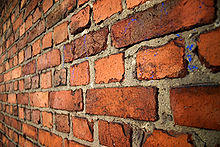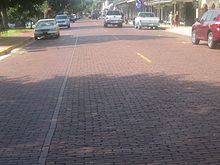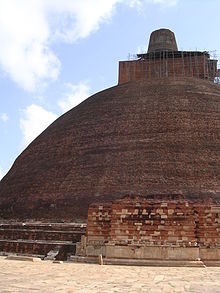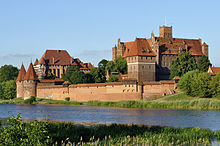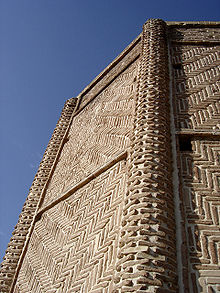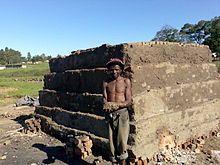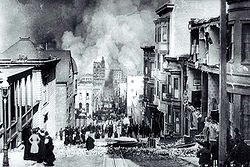- Brick
-
For other uses, see Brick (disambiguation).
A brick is a block of ceramic material used in masonry construction, usually laid using various kinds of mortar.[1] It has been regarded as one of the longest lasting and strongest building materials used throughout history.
Contents
History
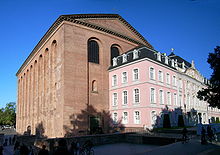 The Roman Basilica Aula Palatina in Trier, Germany, built in the 4th century with fired bricks as audience hall for Constantine I
The Roman Basilica Aula Palatina in Trier, Germany, built in the 4th century with fired bricks as audience hall for Constantine I
The oldest discovered bricks, originally made from shaped mud and dating to before 7500 B.C. were found at Tell Aswad then later in the upper Tigris region and in southeast Anatolia close to Diyarbakir.[2] Other more recent findings, dated between 7,000 and 6,395 B.C., come from Jericho and Catal Hüyük. The first sun-dried bricks were made in Mesopotamia (what is now Iraq), in the ancient city of Ur in about 4000 BC, although the arch used for drying the bricks was not actually found.[3]
Other examples of civilizations who used mud brick include the ancient Egyptians[3] and the Indus Valley Civilization, where it was used exclusively. In particular, it is evident from the ruins of Buhen, Mohenjo-daro and Harappa.
The ancient Jetavanaramaya stupa in Anuradhapura, Sri Lanka is one of the largest brick structures in the world.
The Romans made use of fired bricks, and the Roman legions, which operated mobile kilns[citation needed], introduced bricks to many parts of the empire. Roman bricks are often stamped with the mark of the legion that supervised their production. The use of bricks in southern and western Germany, for example, can be traced back to traditions already described by the Roman architect Vitruvius.
China
In pre-modern China, brick-making was the job of a lowly and unskilled artisan, but a kiln master was respected as a step above the former.[4] Early traces of bricks were found in a ruin site in Xi'an in 2009 dated back about 3800 years ago. Before this discovery, it is widely believed that bricks appeared about 3000 years ago in the Western Zhou dynasty since the earliest bricks were found in Western Zhou ruins.[5][6][7] These bricks are the earliest bricks discovered that were made by a fired process.[8] Early descriptions of the production process and glazing techniques used for bricks can be found in the Song Dynasty carpenter's manual Yingzao Fashi, published in 1103 by the government official Li Jie, who was put in charge of overseeing public works for the central government's construction agency. The historian Timothy Brook writes of the production process in Ming Dynasty China (aided with visual illustrations from the Tiangong Kaiwu encyclopedic text published in 1637):
...the kilnmaster had to make sure that the temperature inside the kiln stayed at a level that caused the clay to shimmer with the colour of molten gold or silver. He also had to know when to quench the kiln with water so as to produce the surface glaze. To anonymous laborers fell the less skilled stages of brick production: mixing clay and water, driving oxen over the mixture to trample it into a thick paste, scooping the paste into standardized wooden frames (to produce a brick roughly 42 cm long, 20 cm wide, and 10 cm thick), smoothing the surfaces with a wire-strung bow, removing them from the frames, printing the fronts and backs with stamps that indicated where the bricks came from and who made them, loading the kilns with fuel (likelier wood than coal), stacking the bricks in the kiln, removing them to cool while the kilns were still hot, and bundling them into pallets for transportation. It was hot, filthy work.[9]
The idea of signing the worker's name and birth date on the brick and the place where it was made was not new to the Ming era and had little or nothing to do with vanity.[10] As far back as the Qin Dynasty (221 BC–206 BC), the government required blacksmiths and weapon-makers to engrave their names onto weapons in order to trace the weapons back to them, lest their weapons should prove to be of a lower quality than the standard required by the government.[11]
Europe
In the 12th century, bricks from Northern-Western Italy were re-introduced to Northern Germany, where an independent tradition evolved. It culminated in the so-called brick Gothic, a reduced style of Gothic architecture that flourished in Northern Europe, especially in the regions around the Baltic Sea which are without natural rock resources. Brick Gothic buildings, which are built almost exclusively of bricks, are to be found in Denmark, Germany, Poland, and Russia.
During the Renaissance and the Baroque, visible brick walls were unpopular and the brickwork was often covered with plaster. It was only during the mid-18th century that visible brick walls regained some degree of popularity, as illustrated by the Dutch Quarter of Potsdam, for example.
The transport in bulk of building materials such as bricks over long distances was rare before the age of canals, railways, roads and heavy goods vehicles. Before this time bricks were generally made close to their point of intended use. It has been estimated[by whom?] that in England in the 18th century carrying bricks by horse and cart for ten miles (16 km) over the poor roads then existing could more than double their price.[citation needed]
Bricks were often used for reasons of speed and economy, even in areas where stone was available. The buildings of the Industrial Revolution in Britain were largely constructed of brick and timber due to the demand created. During the building boom of the 19th century in the eastern seaboard cities of Boston and New York City, for example, locally made bricks were often used in construction in preference to the brownstones of New Jersey and Connecticut for these reasons.
The trend of building upwards for offices that emerged towards the beginning of the 19th century displaced brick in favor of cast and wrought iron and later steel and concrete. Some early 'skyscrapers' were made in masonry, and demonstrated the limitations of the material – for example, the Monadnock Building in Chicago (opened in 1896) is masonry and just 17 stories high; the ground walls are almost 6 feet (1.8 m) thick, clearly building any higher would lead to excessive loss of internal floor space on the lower floors. Brick was revived for high structures in the 1950s following work by the Swiss Federal Institute of Technology[disambiguation needed
 ] and the Building Research Establishment in Watford, UK. This method produced 18-story structures with bearing walls no thicker than a single brick (150–225 mm). This potential has not been fully developed because of the ease and speed in building with other materials; in the late-20th century brick was confined to low- or medium-rise structures or as a thin decorative cladding over concrete-and-steel buildings or for internal non-load-bearing walls.
] and the Building Research Establishment in Watford, UK. This method produced 18-story structures with bearing walls no thicker than a single brick (150–225 mm). This potential has not been fully developed because of the ease and speed in building with other materials; in the late-20th century brick was confined to low- or medium-rise structures or as a thin decorative cladding over concrete-and-steel buildings or for internal non-load-bearing walls.Methods of manufacture
"Bricks" for building may be made from clay, shale, soft slate, calcium silicate, concrete, or shaped from quarried stone. However, true bricks are ceramic, and therefore created by the action of heat and cooling.
Clay is the most common material, with modern clay bricks formed in one of three processes - soft mud, dry press, or extruded.
Normally, brick contains the following ingredients[12]:
- Silica (sand) - 50% to 60% by weight
- Alumina (clay) - 20% to 30% by weight
- Lime - 2 to 5% by weight
- Iron oxide - 5 to 6% (not greater than 7%) by weight
- Magnesia - less than 1% by weight
Mud bricks
The soft mud method is the most common, as it is the most economical. It starts with the raw clay, preferably in a mix with 25-30% sand to reduce shrinkage. The clay is first ground and mixed with water to the desired consistency. The clay is then pressed into steel moulds with a hydraulic press. The shaped clay is then fired ("burned") at 900-1000 °C to achieve strength.
Rail kilns
In modern brickworks, this is usually done in a continuously fired tunnel kiln, in which the bricks move slowly through the kiln on conveyors, rails, or kiln cars to achieve consistency for all bricks. The bricks often have added lime, ash, and organic matter to speed the burning.
Bull's Trench Kilns
In India, brick making is typically a manual process. The most common type of brick kiln in use there are Bull's Trench Kiln (BTK), based on a design developed by British engineer W. Bull in the late 19th century.
An oval or circular trench, 6–9 meters wide, 2-2.5 meters deep, and 100–150 meters in circumference, is dug. A tall exhaust chimney is constructed in the centre. Half or more of the trench is filled with "green" (unfired) bricks which are stacked in an open lattice pattern to allow airflow. The lattice is capped with a roofing layer of finished brick.
In operation, new green bricks, along with roofing bricks, are stacked at one end of the brick pile; cooled finished bricks are removed from the other end for transport. In the middle the brick workers create a firing zone by dropping fuel (coal, wood, oil, debris, and so on.) through access holes in the roof above the trench.
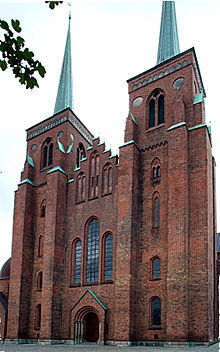 West face of Roskilde Cathedral in Roskilde, Denmark.
West face of Roskilde Cathedral in Roskilde, Denmark.
The advantage of the BTK design is a much greater energy efficiency compared with clamp or scove kilns. Sheet metal or boards are used to route the airflow through the brick lattice so that fresh air flows first through the recently burned bricks, heating the air, then through the active burning zone. The air continues through the green brick zone (pre-heating and drying them), and finally out the chimney where the rising gases create suction which pulls air through the system. The reuse of heated air yields savings in fuel cost.
As with the rail process above, the BTK process is continuous. A half dozen laborers working around the clock can fire approximately 15,000-25,000 bricks a day. Unlike the rail process, in the BTK process the bricks do not move. Instead, the locations at which the bricks are loaded, fired, and unloaded gradually rotate through the trench.[13]
Dry pressed bricks
The dry press method is similar to mud brick but starts with a much thicker clay mix, so it forms more accurate, sharper-edged bricks. The greater force in pressing and the longer burn make this method more expensive.
Extruded bricks
For extruded bricks the clay is mixed with 10-15% water (stiff extrusion) or 20-25% water (soft extrusion). This is forced through a die to create a long cable of material of the proper width and depth. This is then cut into bricks of the desired length by a wall of wires. Most structural bricks are made by this method, as it produces hard, dense bricks, and suitable dies can produce holes or other perforations. The introduction of holes reduces the volume of clay needed, and hence the cost. Hollow bricks are lighter and easier to handle, and have thermal properties different from solid bricks. The cut bricks are hardened by drying for 20 to 40 hours at 50 to 150 °C before being fired. The heat for drying is often waste heat from the kiln. European-style extruded bricks or blocks are used in single-wall construction with finishes applied inside and outside. Their many voids are a greater proportion of the volume than the solid, thin walls of fired clay. Such bricks are made in 15, 25, 30, 42 and 50-cm widths. Some models have very high thermal insulation performance suitable for zero-energy buildings.
Calcium silicate bricks
The raw materials for calcium silicate bricks include lime mixed with quartz, crushed flint or crushed siliceous rock together with mineral colourants. The materials are mixed and left until the lime is completely hydrated, the mixture is then pressed into moulds and cured in an autoclave for two or three hours to speed the chemical hardening. The finished bricks are very accurate and uniform, although the sharp arrises need careful handling to avoid damage to brick (and bricklayer). The bricks can be made in a variety of colours, white is common but pastel shades can be achieved.
Csk bricks are common in Sweden, especially in houses built or renovated in the 1970s,, and are known as "Mexitegel" (en: Mexi[can] Bricks).
In India these are known as Fly ash bricks, manufactured using the FaL-G (fly ash, lime and gypsum) process.
Calcium silicate bricks are also manufactured in Canada and the United States, and meet the criteria set forth in ASTM C73 - 10 Standard Specification for Calcium Silicate Brick (Sand-Lime Brick). It has lower embodied energy than cement based man-made stone and clay brick[citation needed].
Influence on fired colour
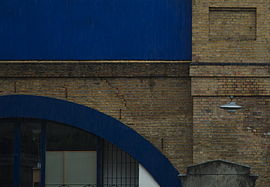 Yellow London Stocks at Waterloo
Yellow London Stocks at Waterloo
The fired colour of clay bricks is influenced by the chemical and mineral content of raw materials, the firing temperature and the atmosphere in the kiln. For example pink coloured bricks are the result of a high iron content, white or yellow bricks have a higher lime content. Most bricks burn to various red hues, if the temperature is increased the colour moves through dark red, purple and then to brown or grey at around 1,300 °C (2,372 °F). Calcium silicate bricks have a wider range of shades and colours, depending on the colourants used. The names of bricks may reflect their origin and colour, such as London stock brick and Cambridgeshire White.
"Bricks" formed from concrete are usually termed blocks, and are typically pale grey in colour. They are made from a dry, small aggregate concrete which is formed in steel moulds by vibration and compaction in either an "egglayer" or static machine. The finished blocks are cured rather than fired using low-pressure steam. Concrete blocks are manufactured in a much wider range of shapes and sizes than clay bricks and are also available with a wider range of face treatments - a number of which are to simulate the appearance of clay bricks.
An impervious and ornamental surface may be laid on brick either by salt glazing, in which salt is added during the burning process, or by the use of a "slip," which is a glaze material into which the bricks are dipped. Subsequent reheating in the kiln fuses the slip into a glazed surface integral with the brick base.
Natural stone bricks are of limited modern utility, due to their enormous comparative mass, the consequent foundation needs, and the time-consuming and skilled labour needed in their construction and laying. They are very durable and considered more handsome than clay bricks by some. Only a few stones are suitable for bricks. Common materials are granite, limestone and sandstone. Other stones may be used (for example, marble, slate, quartzite, and so on.) but these tend to be limited to a particular locality.
Optimal dimensions, characteristics, and strength
For efficient handling and laying bricks must be small enough and light enough to be picked up by the bricklayer using one hand (leaving the other hand free for the trowel). Bricks are usually laid flat and as a result the effective limit on the width of a brick is set by the distance which can conveniently be spanned between the thumb and fingers of one hand, normally about four inches (about 101 mm). In most cases, the length of a brick is about twice its width, about eight inches (about 203 mm) or slightly more. This allows bricks to be laid bonded in a structure to increase its stability and strength (for an example of this, see the illustration of bricks laid in English bond, at the head of this article). The wall is built using alternating courses of stretchers, bricks laid longways and headers, bricks laid crossways. The headers tie the wall together over its width.
A bigger brick makes for a thicker (and thus more insulating) wall. Historically, this meant that bigger bricks were necessary in colder climates (see for instance the slightly larger size of the Russian brick in table below), while a smaller brick was adequate, and more economical, in warmer regions. A notable illustration of this correlation is the Green Gate in Gdansk; built in 1571 of imported Dutch brick, too small for the colder climate of Gdansk, it was notorious for being a chilly and drafty residence. Nowadays this is no longer an issue, as modern walls typically incorporate specialized insulation materials.
The correct brick for a job can be picked from a choice of colour, surface texture, density, weight, absorption and pore structure, thermal characteristics, thermal and moisture movement, and fire resistance.
Face brick ("house brick") sizes,[14] (alphabetical order) Standard Imperial Metric  Australia
Australia9 × 4⅓ × 3 in 230 × 110 × 76 mm  Germany
Germany9 × 4¼ × 2¾ in 240 × 115 × 71 mm  India
India9 × 4¼ × 2¾ in 228 × 107 × 69 mm  Romania
Romania9 × 4¼ × 2½ in 240 × 115 × 63 mm  Russia
Russia10 × 4¾ × 2½ in 250 × 120 × 65 mm  South Africa
South Africa8¾ × 4 × 3 in 222 × 106 × 73 mm  Sweden
Sweden10 × 4¾ × 2½ in 250 × 120 × 62 mm  United Kingdom
United Kingdom8½ × 4 × 2½ in 215 × 102.5 × 65 mm  United States
United States8 × 4 × 2¼ in 203 × 102 × 57 mm In England, the length and the width of the common brick has remained fairly constant over the centuries (but see brick tax), but the depth has varied from about two inches (about 51 mm) or smaller in earlier times to about two and a half inches (about 64 mm) more recently. In the United Kingdom, the usual size of a modern brick is 215 × 102.5 × 65 mm (about 8 5⁄8 × 4 1⁄8 × 2 5⁄8 inches), which, with a nominal 10 mm (3⁄8 inch) mortar joint, forms a unit size of 225 × 112.5 × 75 mm (9 × 4 1⁄2 × 3 inches), for a ratio of 6:3:2. In the United States, modern bricks are usually about 8 × 4 × 2 1⁄4 inches (203 × 102 × 57 mm).
Some brickmakers create innovative sizes and shapes for bricks used for plastering (and therefore not visible) where their inherent mechanical properties are more important than the visual ones.[15] These bricks are usually slightly larger, but not as large as blocks and offer the following advantages:
- a slightly larger brick requires less mortar and handling (fewer bricks) which reduces cost
- ribbed exterior aids plastering
- more complex interior cavities allow improved insulation, while maintaining strength.
Blocks have a much greater range of sizes. Standard coordinating sizes in length and height (in mm) include 400×200, 450×150, 450×200, 450×225, 450×300, 600×150, 600×200, and 600×225; depths (work size, mm) include 60, 75, 90, 100, 115, 140, 150, 190, 200, 225, and 250. They are usable across this range as they are lighter than clay bricks. The density of solid clay bricks is around 2,000 kg/m³: this is reduced by frogging, hollow bricks, and so on.; but aerated autoclaved concrete, even as a solid brick, can have densities in the range of 450–850 kg/m³.
Bricks may also be classified as solid (less than 25% perforations by volume, although the brick may be "frogged," having indentations on one of the longer faces), perforated (containing a pattern of small holes through the brick removing no more than 25% of the volume), cellular (containing a pattern of holes removing more than 20% of the volume, but closed on one face), or hollow (containing a pattern of large holes removing more than 25% of the brick's volume). Blocks may be solid, cellular or hollow
The term "frog" for the indentation on one bed of the brick is a word that often excites curiosity as to its origin. The most likely explanation is that brickmakers also call the block that is placed in the mould to form the indentation a frog. Modern brickmakers usually use plastic frogs but in the past they were made of wood. When these are wet and have clay on them they resemble the amphibious kind of frog and this is where they got their name. Over time this term also came to refer to the indentation left by them.
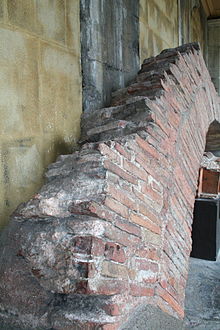 Brick arch from a vault in Roman Bath - England
Brick arch from a vault in Roman Bath - England
 A brick section of the old Dixie Highway, United States
A brick section of the old Dixie Highway, United States
The compressive strength of bricks produced in the United States ranges from about 1000 lbf/in² to 15,000 lbf/in² (7 to 105 MPa or N/mm² ), varying according to the use to which the brick are to be put. In England clay bricks can have strengths of up to 100 MPa, although a common house brick is likely to show a range of 20–40 MPa.
Use
Bricks are used for building and pavement. In the USA, brick pavement was found incapable of withstanding heavy traffic, but it is coming back into use as a method of traffic calming or as a decorative surface in pedestrian precincts. For example, in the early 1900s, most of the streets in the city of Grand Rapids, Michigan were paved with brick. Today, there are only about 20 blocks of brick paved streets remaining (totalling less than 0.5 percent of all the streets in the city limits).[16]
Bricks in the metallurgy and glass industries for lining furnaces. They have various uses, especially refractory bricks such as silica, magnesia, chamotte and neutral (chromomagnesite) refractory bricks. This type of brick must have good thermal shock resistance, refractoriness under load, high melting point, and satisfactory porosity. There is a large refractory brick industry, especially in the United Kingdom, Japan, the United States, and the Netherlands.
In the United Kingdom, bricks have been used in construction for centuries. Until recently, almost all houses were built almost entirely from bricks. Although many houses in the UK are now built using a mixture of concrete blocks and other materials, many houses are skinned with a layer of bricks on the outside for aesthetic appeal.
Engineering bricks are used where strength, low water porosity or acid (flu gas) resistance are needed.
In the UK a redbrick university is one founded and built in the Victorian era, often as a technical college. The term is used as differentiation from older, more classics-oriented universities.
Colombian architect Rogelio Salmona was noted for his extensive use of red brick in his buildings and for using natural shapes like spirals, radial geometry and curves in his designs.[17] Most buildings in Colombia are made of brick, given the abundance of clay in equatorial countries like this one.
Limitations
Starting in the twentieth century, the use of brickwork declined in many areas due to earthquakes. The San Francisco earthquake of 1906 revealed the weaknesses of brick buildings in earthquake-prone areas. Most buildings in San Francisco collapsed during the earthquake, due to the cement-based mortar used to hold the bricks together. During seismic events, the mortar cracks and crumbles, and the bricks are no longer held together.
Gallery
-
A brick kiln, Tamilnadu, India
-
Brick sculpturing on Thornbury Castle, Thornbury, near Bristol, England. The chimneys were erected in 1514
-
Ishtar Gate of Babylon in the Pergamon Museum, Berlin, Germany
-
A typical brick house in the Netherlands.
-
A typical dutch farmhouse near Rotterdam, Netherlands
See also
- Brick tinting
- Brickwork
- Brickyard
- Ceramics
- Clinker brick
- Concrete masonry unit (cinder block)
- Fire brick
- Masonry
- Millwall brick
- Mortar
- Mudbrick
- Roman brick
- Tile
- Wienerberger
Notes
- ^ World Book Encyclopedia
- ^ IFP Orient - Tell Aswad
- ^ a b History of brickmaking
- ^ Brook, 19–20
- ^ Earliest Chinese building brick appeared in Xi'an (中國最早磚類建材在西安現身)
- ^ China's earliest building material
- ^ China's first brick, possible earliest brick in China (藍田出土"中華第一磚" 疑似我國最早的"磚")
- ^ Earliest fired brick discovered in Xi'an (西安發現全球最早燒制磚)
- ^ Brook, 20–21.
- ^ Brook, 22.
- ^ Brook, 22–23.
- ^ Constituents of Brick
- ^ Pakistan Environmental Protection Agency, Brick Kiln Units (PDF file)
- ^ http://www.crammix.co.za/export_info.htm Crammix, Export Information - product options
- ^ Crammix Maxilite
- ^ Michigan | Success Stories | Preserve America | Office of the Secretary of Transportation | U.S. Department of Transportation
- ^ http://www.nytimes.com/2007/10/06/arts/06salmona.html?_r=1&ref=obituaries&oref=slogin
References
- Aragus, Philippe (2003) (in French), Brique et architecture dans l'Espagne médiévale, Bibliothèque de la Casa de Velazquez, 2, Madrid
- Badstübner, E; Schumann, D, eds. (since 1997) (in German), Studien zur Backsteinarchitektur, 7, Berlin
- Brook, Timothy (1998), The Confusions of Pleasure: Commerce and Culture in Ming China, Berkeley: University of California Press, ISBN 0-520-22154-0
- Campbell, James W.; Pryce, Will, photographer (2003), Brick: a World History,, London & New York: Thames & Hudson
- Coomands, Thomas; VanRoyen, Harry, eds. (2008), "Novii Monasterii, 7", Medieval Brick Architecture in Flanders and Northern Europe, Koksijde: Ten Duinen
- Cramer, J.; Sack, D., eds. (since 2004) (in German), Berliner Beiträge zur Bauforschung und Denkmalpflege, 5, Petersberg
- Das, Saikia Mimi; Das, Bhargab Mohan; Das, Madan Mohan (2010), Elements of Civil Engineering, New Delhi: PHI Learning Private Limited, ISBN 978-81-203-4097-8
- Kornmann, M. (2007), Clay Bricks and Roof Tiles, Manufacturing and Properties, Paris: Lasim, ISBN 2-9517765-6-X
- Plumbridge, Andrew; Meulenkamp, Wim (2000), Brickwork. Architecture and Design, London: Seven Dials, ISBN 1-84188-039-6
Further reading
- Dobson, E. A. (1850) (2 pt.), Rudimentary Treatise on the Manufacture of Bricks and Tiles, London: John Weale
- Hudson, Kenneth (1972) Building Materials; chap. 3: Bricks and tiles. London: Longman; pp. 28–42
- Lloyd, N. (1925) History of English Brickwork. London: H. Greville Montgomery
Dewan, Kader 2010
External links
- Brick in 20th century architecture
- Brick Industry Association
- Mason Contractors Association of America
- Masonry Institute of America
- Western States Clay Products Association
- "Bricks Made Automatically by One-Man Machine" Popular Mechanics, April 1935, pg. 523 bottom-left
Stonemasonry Types Materials List of stone • Artificial stone • Brick • Cast stone • Decorative stones • Dimension stone • Fieldstone • Flagstone • Gabions • Granite • Marble • Mortar • Sandstone • SlateTools Angle grinder • Bush hammer • Ceramic tile cutter • Chisel • Diamond blade • Lewis (lifting appliance) • Non-explosive demolition agents • Plug and feather • Stonemason's hammer • StraightedgeTechniques Products Organizations Roads and junctions Types of road By countryGermany · Croatia · Spain · Italy · Portugal · Czech Republic · Ireland · United States (U.S. Routes · Interstates)Main roadsArterial road · Collector road · Express-collector setup · Farm-to-market road · Highway · Link road · Two-lane expressway · 2+1 road (Parkway · Super two · 2+2 road) · Trunk road · Highway systems by countryLocal roadsBoulevard · Frontage road · Road · Single carriageway · Street · Alley · Backroad · Cul-de-sac · Driveway · Lane · Primitive road · Side roadOther termsSurfaces Asphalt concrete · Brick · Chipseal · Cobblestone · Concrete · Corduroy · Dirt · Gravel · Ice · Macadam · Oiled (bitumen) · Plank · Sett · TarmacRoad junctions Cloverleaf · Diamond · Directional T · Diverging diamond · Parclo · Trumpet · SPUI · Stack · Three-level diamond · Raindrop · Roundabout interchangeRaised pavement marker · List of road types by features · Central reservation · Sidewalk · Lane Categories:
Wikimedia Foundation. 2010.

